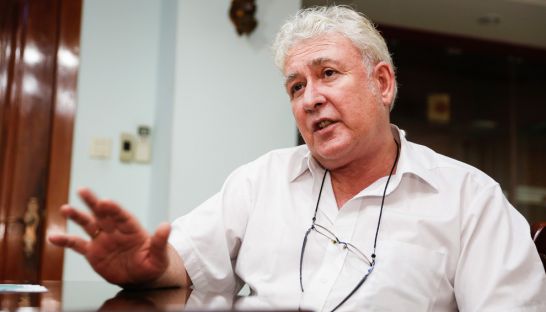Solar’s future looks a bit brighter
Solar’s future looks a bit brighter
For a country drenched in sunshine, Cambodia has made remarkably little effort to harness the abundant energy of the sun. The Post’s Kali Kotoski sat down with Jim Gramberg, CEO of Solar Partner Asia, to discuss what is holding back solar energy initiatives, and recent baby steps toward private sector involvement.

Solar companies have been trying to operate in Cambodia for many years. Why hasn’t it taken off?
In Cambodia, nobody has experience in contract financing or bank specialists that are knowledgeable enough to value renewable energy projects. It is purely a lack of knowledge, because if you look around the world, it is not a risky investment. Worldwide there are over 12,000 solar power plants that have been successfully erected. I predict eventually Cambodia will become like the Philippines in terms of solar. They started off with 3 and 5-megawatt (MW) projects, and now everybody is talking about 30 MW projects.
Your company recently signed a 5 MW agreement with Tai Seng Special Economic Zone in Bavet. Why target that location?
The situation in Bavet is very bad for electricity. There are many power cuts due to the lack of supply and high demand. The way things work now is that if a neighbouring SEZ turns on their machines at the same time there are power cuts. Electricité du Cambodge (EdC) is trying to come with a solution. They just finalised a substation in Bavet and they have tendered a 10 MW solar power plant.
But still, factories have to temporarily close after they spent millions of dollars for investment. There are factory owners that would like to sue the government or EdC because they promised them guaranteed electricity all the while knowing they wouldn’t be able to provide that.
Has the government provided any help to push solar plans?
A good development was lowering the duties on solar components. They lowered it from 35 per cent to 7 per cent. But still every import is a struggle.
I had delays on solar batteries for 10 weeks because some customs guy was saying that they are truck batteries, which are subject to 35-per-cent duty. This is just to frustrate the process, to get you to say “okay, here is money” to get them through customs. The customs officials are all crooked and corrupt, and transport companies have tremendous costs. That is why we invested in our own trucks to handle transportation because things were getting out of hand.
How important is it that EdC develops a feed-in tariff system to purchase excess solar power and link it to the national grid?
If the EdC can build substations to enlarge the grid, and as long as it is done properly, then solar would not face any objections to fitting in with the grid. But the feed-in tariff or net metering for solar is something for the future to make it more profitable. Right now the focus should be on isolated industrial applications.
What do you think of Cambodia’s decision to lean toward hydro and coal-fired electricity generation?
This country has always been looking at hydro, but hydro is not the solution, because now it’s been shown that climate change is causing the failure of hydro. So all those million-dollar investments are a waste of money, and despite all the negative aspects that come with it: taking land from people, killing the fish in the river, changing the substance of the water – it is not necessary and could be avoided.
But hydro is something that had financial backing. Unfortunately, Cambodia chose that direction. Meanwhile, coal-fired power plants have a tremendous environmental impact and that’s just not right for an agricultural country.













